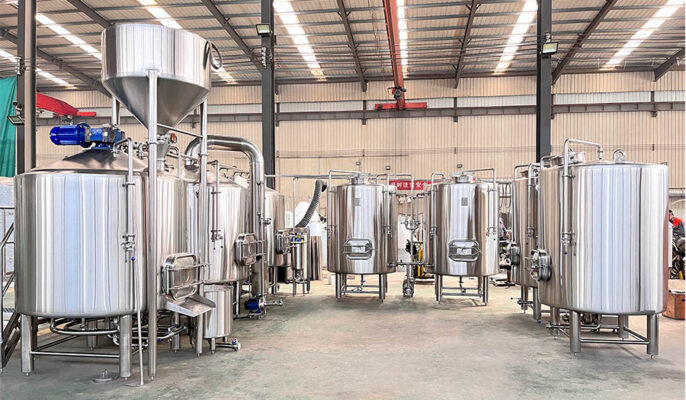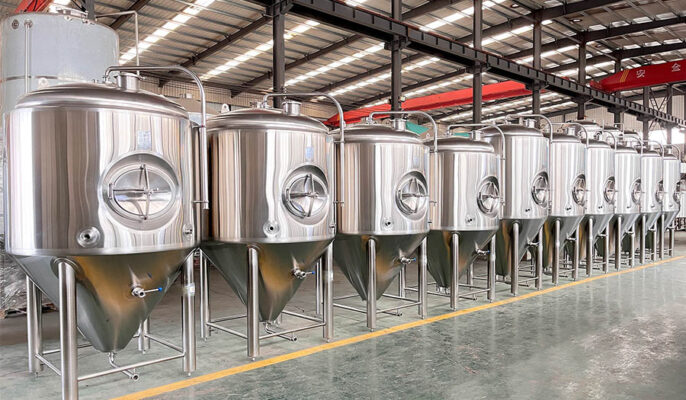Craft beer equipment is becoming a popular hobby. With the continuous development of craft beer equipment, various types of sauce beer equipment have appeared. How do we choose a set of cost-effective and high-quality equipment? this is a difficult task. This guide is an explanation of how to choose cost-effective craft brewing equipment. I hope it will be helpful to you who are planning a brewery.
What is craft beer equipment?
Transportapparatuur
Bucket elevators and shafted screw conveyors were once the standard, and the common problem with bottom storage and the fact that the latter was proportional to the inclination angle and efficiency made it feel a little lacking. Later, the flexible conveying introduced from Europe and the United States solved the problem of conveying malt and malt powder for some time, becoming the preferred solution for long-distance conveying.
Since the efficiency of shaftless conveying is lower than that of shafted conveying, it must face problems such as loud noise, material storage, and secondary crushing caused by non-concentricity. The long-distance, multi-turn, non-retention, low-noise, and high-efficiency transportation method should be pipe chain transportation, made of SUS304 stainless steel, and combined with the roller mill for intermediate discharge. The crushed malt can be sent to any location within 100 meters.
Maischsysteem
The mash system includes a mash tun, malt grinder, lauter barrel, wort pump, steam generator, and heat exchanger.
The brewing process begins with ground malt. Add the ground malt and water to the pot and heat. Next comes the extraction of sugar from the malt. The mash enters the lauter barrel and the wort is separated from the mash. The wort is then boiled at a controlled rate. At this stage, flavors and hops are added to the extract before moving on to the next stage.

Fermentatie systeem
Equipment at this stage includes fermenters, containers for adding yeast, and cooling pumps.
Cool the wort from the previous step and add yeast. This is the most time-consuming step in the entire brewing process. As the yeast begins to cool, it is activated and fermentation begins.
Filtering system
Involves filter pump and filter tank. Any sediment and remaining particles from the brew are filtered out at this stage. The remaining liquid is what makes for brewed beer. Please note that in all small brewery installations, this stage is not mandatory. If you plan to sell unfiltered beer, you can skip investing in filtration equipment.
Bottling system
Bottling systems help you put your finished beer into bottles/kegs for sale. You will need a keg, keg pump, faucet, and bottling equipment suitable for your capacity.
How to choose cost-effective craft beer equipment?
Consider size
Most start-up microbreweries have a brewhouse capacity of 10-30 barrels and have fermenters/beer tanks of the same size. For a new brewery that is unsure of sales and growth, right-sizing the brewery is a balancing act. Starting too big can put a strain on the initial outlay and can turn a bad batch of beer into a costly mistake. Starting too small will make it difficult to keep up with demand and will increase the cost of each batch of ingredients because smaller systems use hops less . Many brewers will tell you that doubling the size of a system is far less than doubling the cost, and that’s usually true.
Materiaalkeuze
First of all, the material must be 304 stainless steel or higher specification 316 stainless steel. The beer brewing process has very high hygiene requirements, and acids and alkalis are used to clean tanks and pipes. 304 or 316 materials have strong acid and alkali resistance and can meet the process requirements of beer brewing. Some manufacturers may use lower specifications of stainless steel, which cannot be distinguished in short-term use. Corrosion will occur in long-term use, affecting the taste of beer.
Customization and scalability
Every small brewery has unique needs and requirements. Look for a supplier that offers customizable equipment to suit your specific brewing process. Whether you need a custom mash tun, fermenter, or bottling line, a supplier who can tailor equipment to your needs will be invaluable. Scalability is also crucial, especially if you plan to expand your brewery in the future. Choose a supplier that offers equipment that can grow with your business, allowing you to increase production capacity as demand grows.
Supplier reputation and references
A supplier’s reputation and references can provide valuable insights into its reliability and customer satisfaction. Research their track record in the industry and seek recommendations from other brewers who have used their equipment. Look for testimonials and case studies on their websites, or ask the vendor for references to contact . Micet group has always been a leader in the brewing industry. The cheap price and high-quality craft brewing equipment have been praised by many customers. Whether you’re building a brewery in your garage or setting it up in a dedicated commercial space, you can contact us. Micet ensures everything goes according to plan and helps you realize your brewing dreams.

|
SELECTION CRITERIA |
OVERWEGINGEN |
|
Partijgrootte |
Estimate the quantity of beer you wish to brew at once. 5 gallon setups are common for home use. Gear handles batch sizes from 1 to 10+ gallons. |
|
All Grain vs Extract |
All grain brewing from base malts offers flexibility but requires mashing equipment. Extract brews are simpler as they skip mashing. |
|
Manual vs Electric |
Manually operated gear has simpler design and lower cost. Electric elements automate temp control & pumping. |
|
Fitted Accessories |
Ensure starter kits include fittings, valves, tubing and small hardware needed to assemble systems. |
|
Uitbreidbaarheid |
Select platforms allowing modular upgrades and additions over time as your system grows. |
|
Structure & Stability |
Gear must safely handle hot liquid without tipping. Durability is also key – stainless steel preferred. |
|
Cost Savings |
Seek biggest bang for buck. Comparison shop for deals on setups offering good quality without unnecessary extras. |
|
Warranty Terms |
Ideally seek at least 1 year coverage of parts & labor from known brands. |
Veelvoorkomend probleem
How much does craft brewery equipment cost?
The final cost depends on the type of small brewery you want to set up. The capacity and volume of beer produced also play a vital role in determining the cost of the equipment.
What are the disadvantages of very cheap brewing equipment?
The cheapest beginner systems are often flimsy in construction and won’t last many uses. Paying a little more can improve durability while still fitting into a tight entry budget.
Can I upgrade or add inexpensive brewing equipment over time?
OK! All brewing equipment setups can be enhanced as your experience level increases. Reserve a budget for future custom extensions to prevent wasting money on an complex system that is beyond a beginner’s current skill level. Start simple and keep growing.




